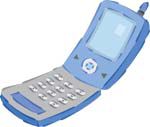These days, nearly everyone owns a cell phone. They’re commonplace. Many have replaced their local phones (land line) with cell phones. There are millions of them in use in the world, and the number is likely to grow.
Surprisingly, few people really understand how cell phone technology even works.
A cell phone operates much like a fancy radio, transmitting and receiving information over airwaves, conveniently removing the need for wires or cables.
Unlike radios, however, cell phones do not directly communicate with each other. Instead, they communicate through a common base station that consists of a radio tower and other equipment that ties it into a much larger communications system.
A cellular phone system is essentially comprised of a large hexagonal grid. The grid is broken down into smaller pieces, called cells. Each cell is typically around 10 square miles in size and has its own local base station that serves cellular users within its reach.
Within each cell, cellular phones use low-power transmitters to communicate with the base station. This ensures that communications do not interfere with communications in adjacent cells, and means phones don’t need large batteries (hence the portability).
Cells are typically close in proximity to each other. When a user leaves the reach of one base station and enters the reach of another, the phone automatically switches communication to the newer station. The transition is seamless to the user.
Cellular base stations are also tied into the global telephone system, so that cellular users can send and receive calls from non-cellular phones.
Interestingly, each cellular call requires two unique frequencies (a duplex channel) – one for sending, and one for receiving. These frequencies are negotiated when the call is initiated. Without dual frequencies, sending and receiving (talking and listening) would not be simultaneous.
Good cellular phones sport a feature called tri-mode, which means that the phone can handle different digital channels (A and B) as well as analog. By default, nearly all modern cell phones use digital signals, because they typically provide superior voice quality, and because they can carry additional information that an analog signal cannot (like text messages, pictures, etc.). Whether a phone uses digital channel A or B depends on the cellular provider.
In the event that the digital signal fails, a tri-mode capable phone will attempt switch to an analog signal. This is because analog signals can travel farther distances than digital signals can. Tri-mode phones are especially useful when you’re far from town – in the mountains, or out on the desert, for example. A tri-mode phone doesn’t guarantee a call can be completed from anywhere, but it does significantly extend the calling range of the phone.
When buying a new phone, it is wise to research the radiation emission levels of the phone. In the past, it was believed that cellular users could contract cancer from the highly localized radiation levels created by the phone. Although such a theory has not been dis-proven, many long-term studies suggest that cell phones do not cause cancer. Nonetheless, the more radiation levels a phone emits, the hotter it will become. Some cell phones get extremely hot and uncomfortable during long conversations. Such phones typically consume more power than normal, which also means shorter battery life.
Safety is also an important issue when using a cellular phone. Although modern cell phones are very small and compact, they can cause a lot of harm if not used properly.
Cell phones should never be used in highly flammable areas, including gas pumps. Never use the phone while refueling your vehicle, no matter how tempting or harmless it may seem. The phone could ignite the fumes and cause an explosion which could harm you and those around you.
Using cell phones while driving should be avoided. Studies have found that the phone is a major distraction, and puts other motorists at risk. Studies have also shown that headsets don’t really help minimize the distraction the phone creates.
Cell phones are useful little inventions, and make communication so convenient. However, a little knowledge about how they work make proper usage so much easier.
Have comments or suggestions for a weekly Tech Tips article? Send an email to webmaster@sunad.com.
Cellular Phones

